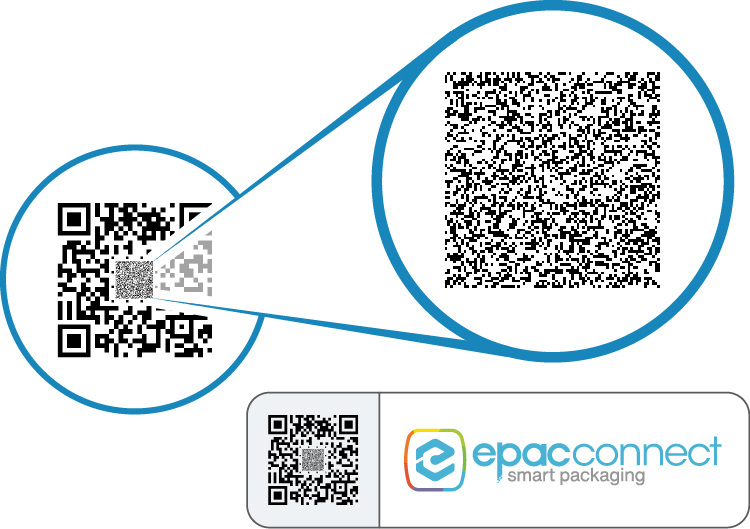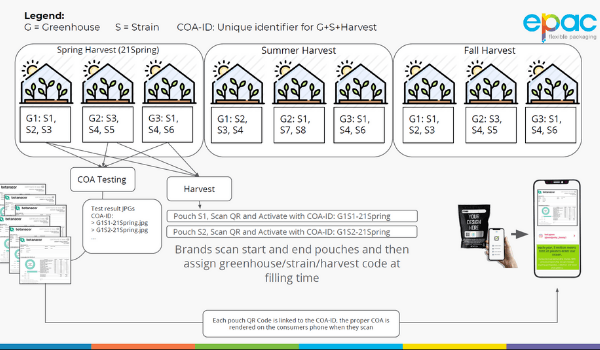Brand trust is critical for attracting, and keeping, customers. In fact, 81% of consumers will make a decision to buy from a brand purely based on the trust they have in that brand.
But that could all come tumbling down by the actions of a few bad actors. According to a 2019 study by Incorporo, 26% of US consumers have inadvertently purchased a counterfeit product, and 52% of those consumers lost trust in the brand after purchasing a fake.
Thankfully, due to today’s advances in blockchain and QR code technology, connected packaging can help you protect your brand and inspire trust with your consumers.
What is Connected Packaging?
In our article, Connected Packaging: The Value of Two Way Communication Between Brand & Consumer, we defined connected packaging as “…a technology available through the power of digital printing where each pouch is assigned a unique digital identity by way of a variable data QR code.”
You can communicate personalized information to consumers when they scan the code with their phone. That can include marketing messages, product recall updates and even brand protection and supply chain management & tracking data.
Each QR code is unique, like a fingerprint. Subsequently, it’s next to impossible for criminals to pass off any copies of your packaging as their own.
How Can Connected Packaging Protect Your Brand?
Connected packaging, powered by variable data – or serialized – QR codes (think ‘unique fingerprint’) can help in three important ways.
1. Product Authentication and Validation
‘The real McCoy’ is a popular term in the English language. There are debates about the origin of the term. One of those stories comes from a true historical account. Elijah McCoy, a Canadian-born African-American whose parents were former slaves, invented an oil drip cup in 1872 to automate lubication of trains.
McCoy patented the device, and orders for this new invention flooded in. Other engineers tried to make their own versions, but these copies were not well received by railroad companies who wanted the ‘real McCoy.’
Today, we use ‘the real McCoy’ to refer to a product that is authentic. The real thing, as Coke says.
Consumers still want the real McCoy, but copycats and counterfeiters have gotten more sophisticated. In fact, counterfeiters cost the U.S. economy $600 billion every year.
With connected packaging, you can deliver product authentication information to consumers to generate trust and protect your brand.
How does it do that?
Serialized QR code unique to each package: We mentioned that each serialized QR code printed on your flexible packaging is unique, like a fingerprint or your irises. This uniqueness enables you to prove to your consumers that the product contained inside the package is the true product.
Anomaly detection: If your packaging is somehow copied, and 10,000 copies are made, the uniqueness of the QR code will catch the counterfeit. The supply chain technology infrastructure behind the code will detect hundreds, if not thousands of scans, setting off alarm bells. This is what is known as anomaly detection.
Delivery of real-time information: Because of the aforementioned technology infrastructure, each unique package can deliver up-to-date information to any consumer who scans the code on your product’s pouch with their phone. The authentic information you deliver can assure consumers they’ve acquired the right product.
2. Supply Chain Tracking
Another way to inspire brand trust and protect your reputation is to deliver information to consumers about your product’s origin and supply chain journey.
Consumer-facing supply chain data: Today, most consumers want to know “…from where their food comes from, production methods or nutritional value,” according to Nichole Busdieker-Jesse, assistant professor with Missouri State University’s William H. Darr College of Agriculture.
By scanning the unique QR code on your product’s package, your consumer can get the whole story about:
- Where your product was grown
- Details about ingredients
- The path is took, from farm, to processing plant, to warehouse, to retail location
And more.
Upstream supply chain data: Additionally, connected packaging can work with upstream supply chain data, which comes in handy if something goes wrong.
For example, an inspector may have detected salmonella in a product you packaged and shipped. That information can be delivered to the 2,864 bags containing the contaminated product, instructing the consumer on how to return the product and get a refund or special offer to make up for the averted tragedy.
3. Regulatory Compliance Information
Finally, you can fulfill regulatory requirements by delivering information, such as a Certificate of Authenticity.
For example, if you sell a natural product, you might grow various strains in various greenhouses, at various seasons of the year.
Regulations require you to communicate that a particular package contains strain 2, grown in greenhouse 3 during the fall harvest.
Delivering all that data on a single package becomes expensive, and it can be onerous to fit all that information on your back. Through a serialized QR code, you can dynamically assign a jpg of the original Certificate of Analysis to each bag as it’s being packaged.
The result? Increased consumer trust while your brand stays in the governing body’s good graces.
Conclusion
Brand trust is essential to the viability of your company. Your customers must be assured they’re purchasing the true, authentic product. They also need to know you have their best interests at heart: that your product is made ethically, with the best ingredients. Finally, they desire that peace of mind that you’re compliant.
But one small breach of trust could kill your business.
Thankfully, with connected packaging you can generate that trust. With the power of serialized QR codes as the cornerstone of your brand trust strategy, you can prove they’ve bought the product they intended to buy, and assure them your product is safe.



